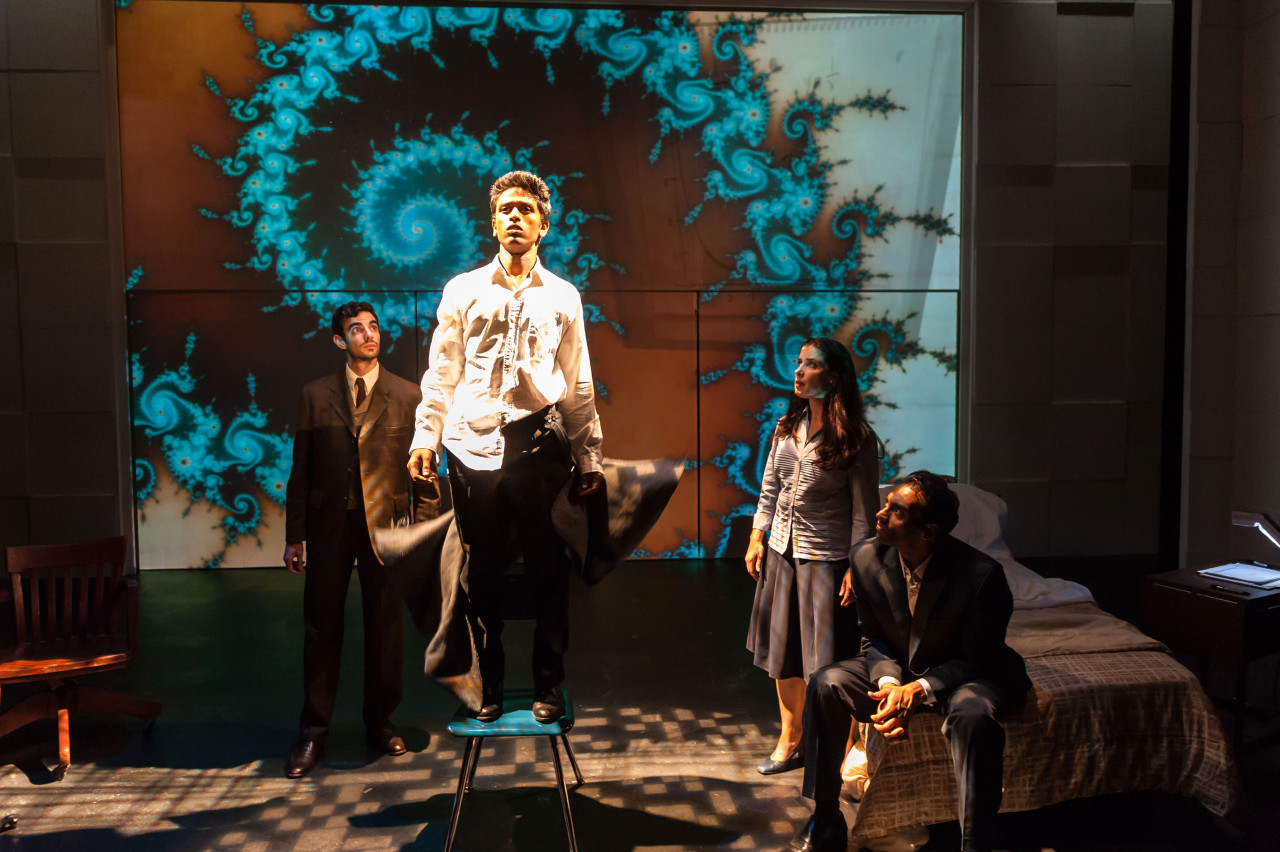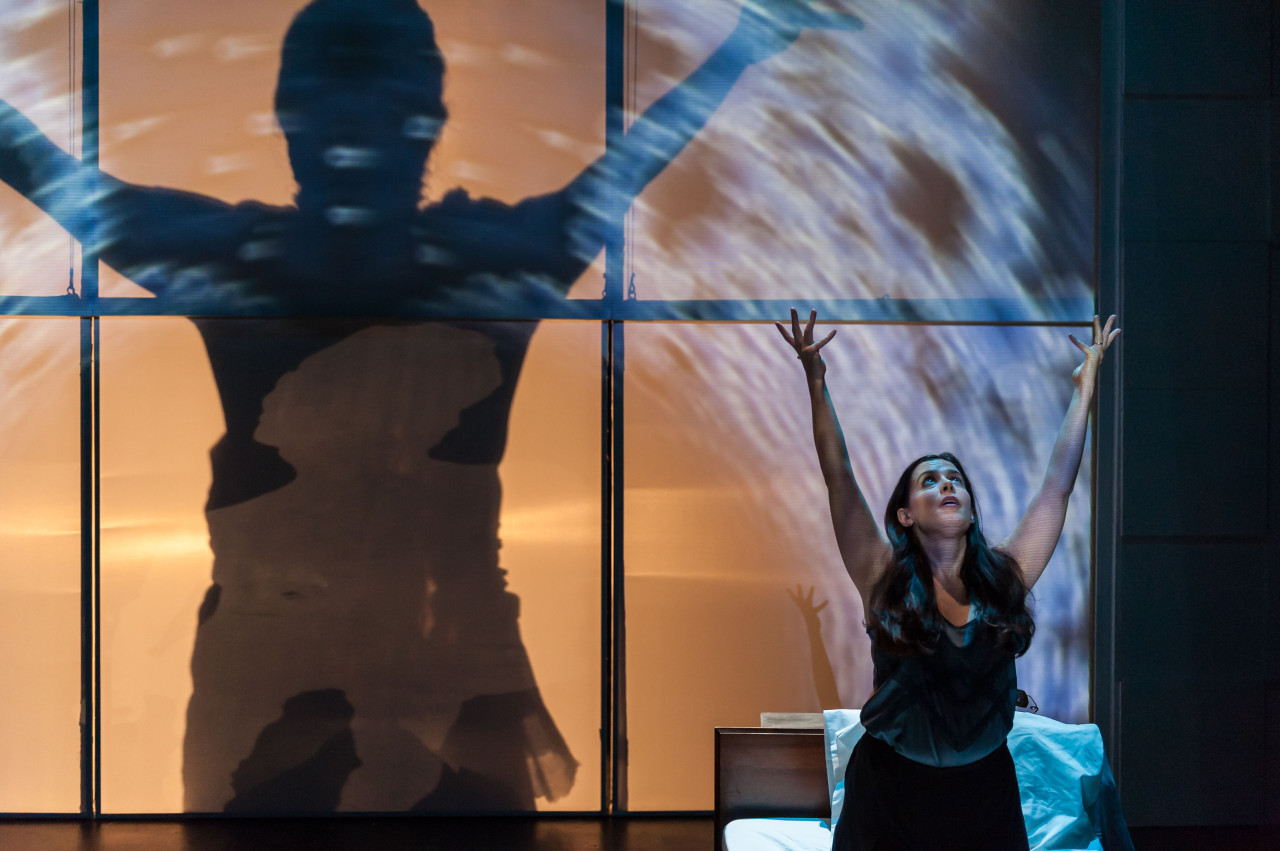Advertisement
'A Disappearing Number’: A Mathematical Path To The Hereafter?

You could count the prizes “A Disappearing Number” won in England in 2007: Evening Standard Award for Best Play, Laurence Olivier Award for Best New Play, Critics’ Circle Theatre award for Best New Play. Or you could just sit back and let the arithmetic wash over you (and the rest of Central Square Theater) as Underground Railway Theater unfurls its quite credible staging of this numerical fantasia created by British polymath Simon McBurney and his troupe, Complicité.
One of URT’s Catalyst Collaborative@MIT projects marrying stage to science, “A Disappearing Number” intersperses the early 20th-century collaboration of Oxford don G.H. Hardy and Indian math prodigy Srinivasa Ramanujan with a fictional, contemporary love story involving a British math professor and an Indian American hedge-fund manager dealing (literally and symbolically) in futures.
Perhaps appropriately, the threads are tied together by a self-described string theorist who only steps out of the lecture hall at the end, when he and the hedge-fund manager meet on a plane and then on a riverbank in India. This perky professor does, however, inform us at the outset that, while the theater surrounding it is artifice, the math onstage is real.
As a play, “A Disappearing Number” bears all the earmarks of a work created by committee: it’s cobbled together, marred by random snatches of this and that, and is far from exquisitely written. The beauty, as it were, is in the numbers, which in Elaine Vaan Hogue’s fluid staging hurtle toward us among various expanding and dividing patterns, their pulsing echoed in the Indian music and dance woven throughout the theater piece.

“A mathematician, like a painter or a poet, is a maker of patterns,” Hardy wrote in “A Mathematician’s Apology,” adding that “beauty is the first test: there is no permanent place in the world for ugly mathematics.” “A Disappearing Number” sets out to demonstrate that not only is math gorgeous but that, stretched toward Infinity, it may also be our closest path to the hereafter.
I’ll admit that I don’t know a Mandelbrot fractal from a Manischewitz wine. But that didn’t stop me from admiring the “pure mathematics” that exercise such a hold on Hardy, Ramanujan and the play’s Ruth Minnen, a Brunel University professor whose lecture on infinite series (culled from an equation of Ramanujan’s) kicks off Complicité’s fragmented meditation.
Among her listeners is brash businessman Al Cooper, who has wandered into Ruth’s lecture from an adjacent conference and hits on her at the end of the talk. He is interested in Infinity, he says, “because that’s where I’m going to go when I die.” His more immediate concern, however, is another numerical series: the digits that comprise Ruth’s phone number.
Al and Ruth’s story is, of course, made up — and Ruth, like Ramanujan, dies young. (This is no spoiler as we watch both deaths unfold repeatedly and largely wordlessly even before they happen.)
This leaves Al to contemplate the continuum of space and time, represented by the addition of ever-diminishing numbers, that he hopes will lead him to some posthumous form of Ruth (whose not-insignificant phone number he spends a large part of the play trying to get transferred, via an outsourced, disembodied representative of British Telephone, to his own mobile device). The true story of Hardy and Ramanujan’s collaboration – which the former called “the one romantic incident in my life” — is both more abstract and, in the theater piece, more remote.
Ramanujan, an unschooled mathematical savant working as a clerk in Madras, was also something of a mystic. “An equation for me,” he opined, “has no meaning unless it expresses a thought of God.” He is easily the play’s most fascinating figure, but many of his scenes are played in silhouette, behind a screen, in one of the upstage blocks that comprise the set (and serve as screens for the ongoing parade of projections). He only comes center stage, briefly, during his ill-fated tenure in Cambridge with Hardy. (A strict vegetarian and workaholic, he contracted tuberculosis and died soon after returning to India.) Paul Melendy’s crisp, obsessive Hardy, too, is often confined to an upstage cubicle. So the production sometimes seems a hypnotic swirl without a center.
But what a brainy kaleidoscope it is, with God, as Ramanujan might remark, in the details – some of them, including Ruth’s passport, birth-control pills and dog-eared copy of “A Mathematician’s Apology,” almost fetishistically treated. And when a cosmic barrage of numbers or equations isn’t rushing at us, other projections are: vividly hued temples and the bustle of India, rain exploding like fireworks, scenery speeding by the windows of a train.

The Indian rhythms, in both the tabla doodlings of musicians Ryan Meyer and Brian Fairley and the dance interludes choreographed by Aparna Sindhoor, lend both precision and East-West atmosphere. There are lively performances, too, especially by Christine Hamel as Ruth, caught between Ramanujan’s spell and Al’s less aesthetic and ascetic orbit, and Amar Srivastava as the ever closing, ever questing Al.
“A Disappearing Number” may not be a thoroughly satisfying drama, but it adds up to a heady intellectual and emotional spectacle.
Carolyn Clay was for many years the theater editor and chief drama critic for the Boston Phoenix. She is a past winner of the George Jean Nathan Award for Dramatic Criticism.